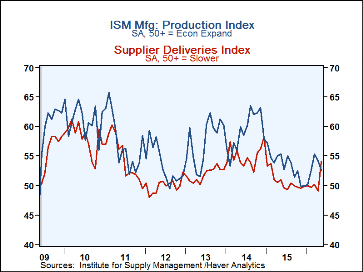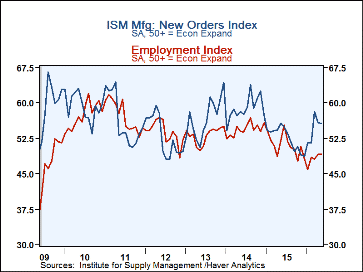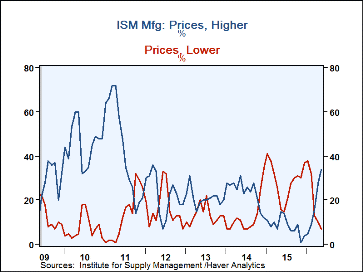 Global| Jun 01 2016
Global| Jun 01 2016Manufacturing ISM Index Reports Negligible Growth
by:Tom Moeller
|in:Economy in Brief
Summary
The ISM Composite Index of manufacturing activity increased slightly to 51.3 during May following an unrevised April decline to 50.8. The index has hovered near the break-even level of 50 for four months, but last month beat [...]
The ISM Composite Index of manufacturing activity increased slightly to 51.3 during May following an unrevised April decline to 50.8. The index has hovered near the break-even level of 50 for four months, but last month beat expectations for 50.4 in the Action Economics Forecast Survey. The data from the Institute for Supply Management (ISM) are diffusion indexes where a reading above 50 indicates an increase in activity. During the last ten years, there has been a 74% correlation between the level of the ISM index and the q/q changed in real GDP.
Deterioration in the production component to 52.6, its lowest level since January. This was offset by a rise in the supplier deliveries index to 54.1, the slowest product delivery speed since December 2014. Elsewhere, the component series were little changed m/m. The new orders index of 55.7 showed roughly the same m/m expansion of order books and the inventory reading of 45.0 showed decumulation for the eleventh straight month. The steady employment series of 49.2 suggested continued hiring declines, but at a rate slower than in January. During the last ten years, there has been an 88% correlation between the figure and the m/m change in factory sector payrolls.
The prices paid index continued its recent improvement with a rise to 63.5, the highest level since June 2011. Thirty-four percent of industries reported higher prices while 7% reported that prices fell.
Other component series, not included in the composite reading, showed mixed performance. The export figure held steady at 52.5, the highest level since November 2014. The imports index also held at 50, also up significantly from the December low of 45.5. The order backlog index declined to 47.0, the lowest level since January.
The figures from the Institute for Supply Management can be found in Haver's USECON database. The expectations number is in Haver's AS1REPNA database.
The Fed's latest Beige Book covering regional economic conditions can be found here.
| ISM Mfg (SA) | May | Apr | Mar | May '15 | 2015 | 2014 | 2013 |
|---|---|---|---|---|---|---|---|
| Composite Index | 51.3 | 50.8 | 51.8 | 53.1 | 51.3 | 55.6 | 53.8 |
| New Orders | 55.7 | 55.8 | 58.3 | 55.6 | 52.6 | 58.9 | 56.8 |
| Production | 52.6 | 54.2 | 55.3 | 55.3 | 53.5 | 59.2 | 57.5 |
| Employment | 49.2 | 49.2 | 48.1 | 52.1 | 51.0 | 54.4 | 53.1 |
| Supplier Deliveries | 54.1 | 49.1 | 50.2 | 50.9 | 50.7 | 55.0 | 51.9 |
| Inventories | 45.0 | 45.5 | 47.0 | 51.5 | 49.0 | 50.8 | 49.4 |
| Prices Paid Index (NSA) | 63.5 | 59.0 | 51.5 | 49.5 | 39.8 | 55.6 | 53.8 |
Tom Moeller
AuthorMore in Author Profile »Prior to joining Haver Analytics in 2000, Mr. Moeller worked as the Economist at Chancellor Capital Management from 1985 to 1999. There, he developed comprehensive economic forecasts and interpreted economic data for equity and fixed income portfolio managers. Also at Chancellor, Mr. Moeller worked as an equity analyst and was responsible for researching and rating companies in the economically sensitive automobile and housing industries for investment in Chancellor’s equity portfolio. Prior to joining Chancellor, Mr. Moeller was an Economist at Citibank from 1979 to 1984. He also analyzed pricing behavior in the metals industry for the Council on Wage and Price Stability in Washington, D.C. In 1999, Mr. Moeller received the award for most accurate forecast from the Forecasters' Club of New York. From 1990 to 1992 he was President of the New York Association for Business Economists. Mr. Moeller earned an M.B.A. in Finance from Fordham University, where he graduated in 1987. He holds a Bachelor of Arts in Economics from George Washington University.










